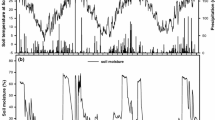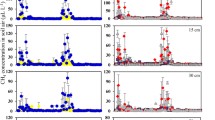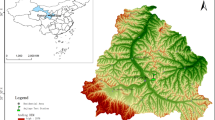Abstract
Aim
Soil available carbon (C) and nitrogen (N) are essential substrates for microbial C and N cycle processes, and under soil hydrothermal conditions, they play a great role in CH4 emission in a rice-based system. However, the associated mechanisms are still not clear. This study aimed to explore the response of CH4 emission to soil hydrothermal conditions after N fertilization.
Methods
A rice–wheat rotation (RW) field experiment with (RW-CN) or without (RW-NN) conventional N fertilization was conducted in Sichuan province, China. The effect of soil CH4 fluxes and the key factors (soil temperature, moisture, and available C and N) driving CH4 emissions were determined with and without N fertilization under a RW system.
Results
During the rice cultivation seasons, cumulative CH4 emissions from RW-CN were 7–9 folds greater (193 ± 11.4 and 302 ± 28.3 kg C ha−1) than that during the wheat cultivation periods (21.7 ± 13.4 and 47.1 ± 20.5 kg C ha−1). However, seasonal CH4 emissions from RW-NN were comparable with those from RW-CN treatment, indicating that N fertilization had no marked effect on CH4 emissions in the present study. During the whole experimental period, the soil temperature sensitivity coefficient (Q10) of CH4 emission from RW-NN treatment was similar to that from RW-CN treatment (6.47 vs 6.69). During the rice-growing seasons, CH4 fluxes linearly positively correlated with soil temperature and dissolved organic carbon (DOC) content, but negatively correlated with soil DOC to dissolved inorganic nitrogen ratio (DOC/DIN) and flood depth (FD) for both treatments. Structural equation model revealed that soil temperature, soil DOC, DOC/DIN, and FD together accounted for 62% and 57% of CH4 emission for RW-CN and RW-NN treatment, respectively.
Conclusions
In summary, to mitigate flooded rice-based CH4 emission, appropriate soil hydrothermal conditions and available C and N substrates should be maintained, such as keeping appropriate flood depth when applying N fertilizer to fields and maintaining soil DOC/DIN > 8.








Similar content being viewed by others
References
Banger K, Tian H, Lu C (2012) Do nitrogen fertilizers stimulate or inhibit methane emissions from rice fields. Glob Chang Biol 18:3259–3267
Bhullar GS, Iravani M, Edwards PJ, Venterink HO (2013) Methane transport and emissions from soil as affected by water table and vascular plants. BMC Ecol 13:1–9
Bodelier PLE (2011) Interactions between nitrogenous fertilizers and methane cycling in wetland and upland soils. Curr Opin Env Sust 3:379–388
Bodelier PLE, Roslev P, Henckel T, Frenzel P (2000) Stimulation by ammonium-based fertilizers of methane oxidation in soil around rice roots. Nature 403:421–424
Bruhn D, Mikkelsen TN, Ãbro J (2009) Effects of temperature, ultraviolet radiation and pectin methyl esterase on aerobic methane release from plant material. Plant Biol 11:43–48
Cai ZC, Xing GX, Yan XY, Xu H, Tsuruta H, Yagi K, Minami K (1997) Methane and nitrous oxide emissions from rice paddy fields as affected by nitrogen fertilisers and water management. Plant Soil 196:7–14
Cai ZC, Tsuruta H, Gao M (2003) Options for mitigating methane emission from a permanently flooded rice field. Glob Change Biol 9:37–45
Cai ZC, Shan Y, Xu H (2007) Effects of nitrogen fertilization on CH4 emissions from rice fields. Soil Sci Plant Nutr 76:649–651
Dong HB, Yao ZS, Zheng XH, Mei BL, Xie BH, Wang R, Deng J, Cui F, Zhu JG (2011) Effect of ammonium-based, non-sulfate fertilizers on CH4 emissions from a paddy field with a typical Chinese water management regime. Atmos Environ 45:1095–1101
Dunfield P, Knowles R (1993) Methane production and consumption in the temperature subarctic peat soils. Soil Biol Biochem 25:321–326
FAO (2014) Statistical Database of the Food and Agricultural Organization of the United Nations (FAOSTAT). Rome, Italy http://faostat.fao.org/faostat/collections?subset=agriculture
Frolking S, Qiu JJ, Boles S, Xiao XM, Liu JY, Zhuang YH, Li CS, Qin XG (2002) Combining remote sensing and ground census data to develop new maps of the distribution office agriculture in China. Glob Biogeochem Cycles 16:1091–1101
Ho A, Frenzel P (2012) Heat stress and methane-oxidizing bacteria: effects on activity and population dynamics. Soil Biol Biochem 50:22–25
Hu X, Su F, Ju X, Gao B, Oenema O, Christie P, Huang B, Jiang R, Zhang F (2013) Greenhouse gas emissions from a wheat-maize doublecropping system with different nitrogen fertilization regimes. Environ Pollut 176:198–207
Huang S, Sun YN, Yu XC, Zhang WJ (2016) Interactive effects of temperature and moisture on CO2 and CH4 production in a paddy soil under long-term different fertilization regimes. Biol Fertil Soils 52:285–294
Huang DD, Yang LN, Xu WJ, Chen QD, Ko JH, Xu QY (2020) Enhancement of the methane removal efficiency via aeration for biochar-amended landfill soil cover. Environ Pollut 263:114413
IPCC (2013) Climate Change 2013: Synthesis Report. Contribution of Working Groups I, II and III to the Fifth Assessment Report of the Intergovernmental Panel on Climate Change. IPCC, Geneva
Islam SF, Groenigen JWV, Jensen LS, Sander BO, Neergaard AD (2018) The effective mitigation of greenhouse gas emissions from rice paddies without compromising yield by early-season drainage. Sci Total Environ 612:1329–1339
Jia ZJ, Cai ZC, Xu H (2001) Effects of rice plants on CH4 production, transport, oxidation and emission in rice paddy soil. Plant Soil 230:211–221
Jiang CS, Wang YS, Zheng XH, Zhu B, Huang Y, Hao QJ (2006) Methane and nitrous oxide emissions from three paddy rice based cultivation systems in Southwest China. Adv Atmos Sci 23:415–424
Kang GD, Cai ZC, Feng XZ (2002) Importance of water regime during the non-rice growing period in winter in regional variation of CH4 emissions from rice fields during following rice growing period in China. Nutr Cycl Agroecosys 64:95–100
Khan I, Fahad S, Wu L, Zhou W, Xu P, Sun Z, Salam A, Imran M, Jiang M, Kuzyakov Y, Hu R (2019) Labile organic matter intensifies phosphorous mobilization in paddy soils by Microbial Iron (III) reduction. Geoderma 352:185–196
King GM, Adamsen APS (1992) Effects of temperature on methane consumption in a forest soil and in pure cultures of the methanotroph methylomonas rubra. Appl Environ Microb 58:2758–2763
Kögel-Knabner I, Amelung W, Cao Z, Fiedler S, Frenzel P, Jahn R, Kalbitz K, Kölbl A, Schloter M (2010) Biogeochemistry of paddy soils. Geoderma 157:1–14
Liu HF, Liu GH, Li Y, Wu X, Liu D, Dai XQ, Xu M, Yang FT (2016) Effects of land use conversion and fertilization on CH4 and N2O fluxes from typical hilly red soil. Environ Sci Pollut Res 23:20269–20280
Lu YH, Wassmann R, Huang CY (2000) Dynamics of dissolved organic carbon and methane emissions in a flooded rice soil. Soil Sci Soc Am J 64:2011–2017
Luo P, Tong X, Liu F, Huang M, Xu J, Xiao RL, Wu JS (2020) Nutrients release and greenhouse gas emission during decomposition of Myriophyllum aquaticum in a sediment-water system. Environ Pollut 260:114015
Ma K, Qiu QF, Lu YH (2009) Microbial mechanism for rice variety control on methane emission from rice field soil. Glob Change Biol 16:3085–3095
Ma WW, Li G, Wu JH, Xu GY, Wu JQ (2020) Respiration and CH4 fluxes in Tibetan peatlands are influenced by vegetation degradation. CATENA 195:104789
Miller GA, Rees RM, Griffiths BS, Ball BC, Cloy JM (2019) The sensitivity of soil organic carbon pools to land management varies depending on former tillage practices. Soil till Res 189:236–242
Morris J, Ye RZ, Silva L, Horwath WR (2017) Nitrogen fertilization had no effect on CH4 and N2O emissions in rice planted in rewetted peatlands. Soil Sci Soc Am J 81:224–232
Parashar DC, Gupta PK, Rai J (1993) Effect of soil temperature on methane emission from paddy fields. Chemosphere 26:247–250
Pittelkow CM, Adviento-Borbe MA, Kessel CV, Hill JE, Linquist BA (2014) Optimizing rice yields while minimizing yield-scaled global warming potential. Glob Change Biol 20:1382–1393
Qin HL, Tang YF, Shen JL, Wang C, Chen CL, Yang J, Liu Y, Chen XB, Li Y, Hou HJ (2018) Abundance of transcripts of functional gene reflects the inverse relationship between CH4 and N2O emissions during mid-season drainage in acidic paddy soil. Biol Fertil Soils 54:885–895
Rasilo T, Hutchins RHS, González CR (2017) Transport and transformation of soil-derived CO2, CH4 and DOC sustain CO2 supersaturation in small boreal streams. Sci Total Environ 579:902–912
Shaaban M, Hu RG, Wu YP, Younas A, Xu XY, Sun Z, Jiang YB, Lin S (2018) Reduction in soil N2O emissions by pH manipulation and enhanced nosZ gene transcription under different water regimes. Environ Pollut 255:113237
Shrestha M, Shrestha PM, Frenzel P, Conrad R (2010) Effect of nitrogen fertilization on methane oxidation, abundance, community structure, and gene expression of methanotrophs in the rice rhizosphere. ISME J 4:1545–1556
Sun HF, Zhou S, Zhang JN, Zhang XX, Wang C (2020) Effects of controlled-release fertilizer on rice grain yield, nitrogen use efficiency, and greenhouse gas emissions in a paddy field with straw incorporation. Field Crops Res 253:107841
Tang SR, Cheng WG, Hu RG, Guigue JL, Kimani SM, Tawaraya K, Xu XK (2016) Simulating the effects of soil temperature and moisture in the off-rice season on rice straw decomposition and subsequent CH4 production during the growth season in a paddy soil. Biol Fertil Soils 52:739–748
Wang K, Zheng X, Pihlatie M, Vesala T, Liu C, Haapanala S, Mammarella I, Rannik Ü, Liu H (2013) Comparison between static chamber and tunable diode laserbased eddy covariance techniques for measuring nitrous oxide fluxes from a cotton field. Agric for Meteorol 171:9–19
Watanabe A, Yamada H, Kimura M (2005) Analysis of temperature effects on seasonal and interannual variation in CH4 emission from rice-planted pots. Agric Ecosyst Environ 105:439–443
Wu L, Tang S, He D, Wu X, Shaaban M, Wang M, Zhao J, Khan I, Zheng X, Hu R (2017) Conversion from rice to vegetable production increases N2O emission via increased soil organic matter mineralization. Sci Total Environ 583:190–201
Xu P, Zhou W, Jiang MD, Muhammad S, Zhou MH, Zhu B, Jiang YB, Ren XJ, Hu RG (2020a) Conversion of winter flooded rice paddy planting to rice-wheat rotation decreased methane emissions during the rice-growing seasons. Soil till Res 198:104490
Xu P, Zhou W, Jiang MD, Muhammad S, Imran K, Jiang YB, Hu RG (2020b) Nitrogen fertilizer application in the rice-growing season can stimulate methane emissions during the subsequent flooded fallow period. Sci Total Environ 744:140632
Ye R, Espe MB, Linquist B, Parikh SJ, Doane TA, Horwath WR (2016) A soil carbon proxy to predict CH4 and N2O emissions from rewetted agricultural peatlands. Agric Ecosyst Environ 220:64–75
Zheng XH, Mei BL, Wang YH, Xie BH, Wang YS, Dong HB, Xu H, Chen GX, Cai ZC, Yue J (2008) Quantification of N2O fluxes from soil-plant systems may be biased by the applied gas chromatograph methodology. Plant Soil 311:211–234
Zhou MH, Zhu B, Bruggemann N, Wang XG, Zheng XH, Butterbach-Bahl K (2015) Nitrous oxide and methane emissions from a subtropical rice-rapeseed rotation system in China: a 3-year field case study. Agric Ecosyst Environ 212:297–309
Zhou MH, Zhu B, Wang XG, Wang YQ (2017a) Long-term field measurements of annual methane and nitrous oxide emissions from a Chinese subtropical wheat-rice rotation system. Soil Biol Biochem 115:21–34
Zhou W, Lin S, Wu L, Zhao JS, Wang ML, Zhu B, Mo YL, Hu RG, Chadwick D, Shaaban M (2017b) Substantial N2O emission during the initial period of the wheat season due to the conversion of winter-flooded paddy to rice-wheat rotation. Atmos Environ 170:269–278
Zhou MH, Wang XG, Wang YQ, Zhu B (2018) A three-year experiment of annual methane and nitrous oxide emissions from the subtropical permanently flooded rice paddy fields of China: Emission factor, temperature sensitivity and fertilizer nitrogen effect. Agr Forest Meteorol 250–251:299–307
Acknowledgements
The authors thank the funding bodies of National Key Research and Development Program of China (2017YFD0800102) and National Program on key Basic Research Project of China (No.2012CB417106) for financial support. In addition, we appreciate the Research Project of Hubei Provincial Department of Education (D20202503) for its support for Hongtao Wu.
Author information
Authors and Affiliations
Corresponding author
Additional information
Responsible Editor: Elizabeth M Baggs.
Publisher's note
Springer Nature remains neutral with regard to jurisdictional claims in published maps and institutional affiliations.
Supplementary Information
Below is the link to the electronic supplementary material.
Rights and permissions
About this article
Cite this article
Xu, P., Zhou, W., Jiang, M. et al. Methane emission from rice cultivation regulated by soil hydrothermal condition and available carbon and nitrogen under a rice–wheat rotation system. Plant Soil 480, 283–294 (2022). https://doi.org/10.1007/s11104-022-05581-4
Received:
Accepted:
Published:
Issue Date:
DOI: https://doi.org/10.1007/s11104-022-05581-4




